Snuffling, sneezing, red eyes and a runny nose… there’s no denying a cat allergy is a pretty unpleasant thing to have. If your body has an aversion to cats, you may think feline ownership is completely off the table. The good news? It’s not! Luckily, there are several hypoallergenic cat breeds that are much less likely to inflict a nasty reaction.
Keen to find out what they are? So are we!
What are hypoallergenic cats?
It first helps to understand what causes cat allergies. It’s widely believed that cat hair leads to allergic reactions, but this isn’t usually the case. Instead, cat allergies are mostly caused by proteins found in cat saliva (a protein called FEL D4) and skin secretions (FEL D1). All cats make these proteins. They’re spread when cats groom themselves and shed hair, causing a reaction in those who are allergic.
So, what makes a cat hypoallergenic? Many hypoallergenic cat breeds make less of these proteins than other cat breeds, while others shed less – resulting in less protein being spread around the home. Interestingly, female cats produce a lower amount of FEL D1 than males, and males create less after they’ve been desexed.
It’s important to note that no cat is 100 per cent allergen-free. However, you may find that those pesky cat allergy symptoms we mentioned earlier are nowhere near as bad.
The 10 best hypoallergenic cat breeds
Without further ado, here are 10 hypoallergenic cats to consider.
Sphynx
The Sphynx is probably the most well-known hypoallergenic cat breed of all – mainly due its lack of hair. While the Sphynx does produce the FEL D1 protein, the fact that it’s hairless means there’s nowhere for the protein to stick to.
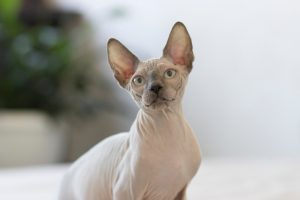
Siamese
The Siamese is a truly lovely cat: it’s loving and affectionate, playful, and known for being very chatty. It’s also a great one for allergy-sufferers, as it sheds much less than other breeds. This means those allergy-causing proteins are less likely to get spread around your home.

Balinese
Thought owning a long-haired cat was out of the question? Fortunately, the beautiful Balinese is an ideal cat for allergy-sufferers. Often known as a long-haired Siamese, this cat produces less FEL D1 protein, doesn’t shed a whole lot, and requires pretty minimal grooming.

Siberian
The Siberian is another long-haired cat that’s great for allergy-sufferers. Like the Balinese, it’s thought this breed makes less FEL D1. The Siberian has a really thick coat that requires regular grooming. But with a decent amount of brushing, you can help minimise the amount of cat hair that ends up around the home.
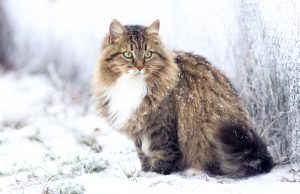
Rex
Both the Devon Rex and Cornish Rex are perfect if you suffer from cat allergies. These cats have very short coats – that sometimes don’t look like coats at all – and they don’t shed a whole lot. Plus, they’re awesome cats: they’re fun, playful, and mischievous, but are equally happy curling up in your lap.
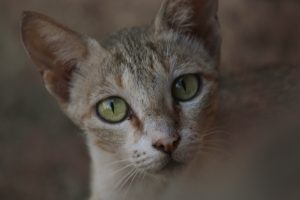
Russian Blue
Russian Blues are known for being incredibly smart and loyal cats. But perhaps what’s not quite as well-known is just how good they are for people with allergies. This is because they produce less FEL D1. That being said, they do shed a little more than some other hypoallergenic breeds, so may not be ideal if you have serious allergies.
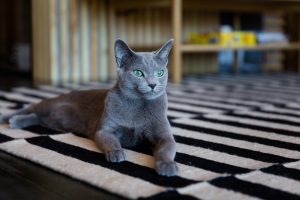
Burmese
The Burmese boasts a beautiful, silky coat that’s relatively low-shedding – making this cat perfect for allergy-sufferers and those who want a pet that doesn’t require much grooming. Add to that the fact that Burmeses are friendly, smart, and playful, and you’ve got yourself one darn fine cat!
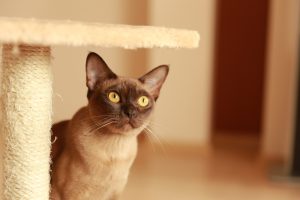
Oriental Shorthair
True to their name, Oriental Shorthairs have short hair. That hair also doesn’t shed very much, meaning these cats are great for anyone with allergies. You’re also likely to have a lot of fun with this breed: Oriental Shorthairs are very energetic and frisky, and require quite a bit of playtime to keep them occupied.
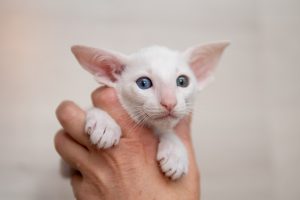
Bengal
The Bengal may look like something out of the jungle, but it’s actually a fantastic house cat that’s loyal and affectionate. It’s also considered a hypoallergenic breed because its coat requires a lot less maintenance, so less saliva is spread around.
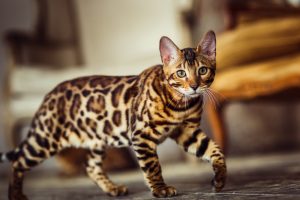
LaPerm
The LaPerm is a slightly lesser-known cat breed, but it’s no less suitable for allergy-sufferers. This cat has a dense, curly coat that doesn’t shed much and also helps trap the allergy-causing proteins. LaPerms are also fiercely loyal and very affectionate, making them excellent sidekicks.
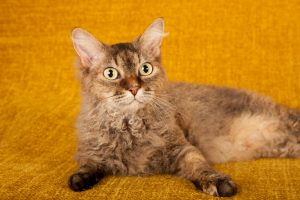
Tips for reducing allergies with cats
While owning a hypoallergenic cat breed can certainly help, there are a few more things you can do to reduce allergy symptoms even further.
- Keep your home relatively clear of hair. Using a good vacuum cleaner for pet hair can minimise the amount of cat fur that ends up around your home. Make sure to get under the couch and pay particularly close attention to rugs and carpets, which trap hair.
- Restrict your cat’s access to certain rooms. You could keep your cat contained to certain parts of the house, like the living room, to avoid getting their hair in areas like your bedroom. If your cat is happy to go outdoors, you could also encourage them to spend more time outside the home to minimise fur inside.
- Circulate fresh air. You can do this by keeping a window open or using a fan. You can also purchase an air purifier, which may help reduce the number of allergens floating around.
- Groom your cat frequently. Even low-shedding cats need semi-regular grooming to remove excess hair and keep their coat healthy. Cat grooming tools like brushes, combs, and even shampoos can help do the job. Yep, you read right! You can bathe your cat every two weeks or so to reduce allergens in their hair. Not game to dunk your kitty in a pool of water? An expert Cat Sitter might be more up to the task!

